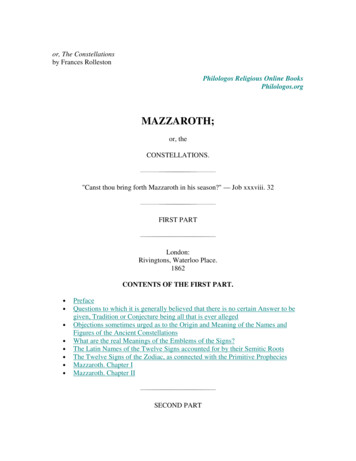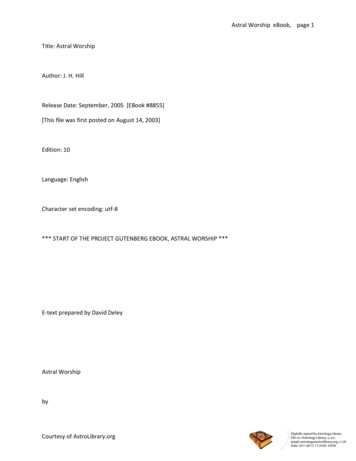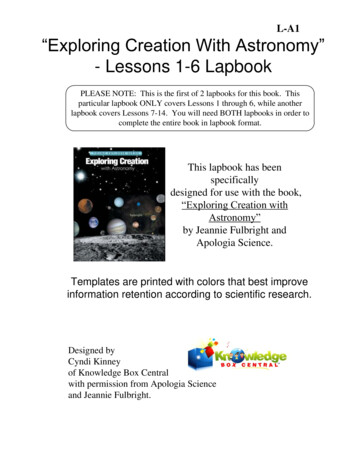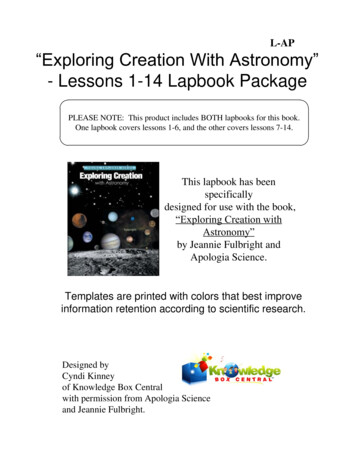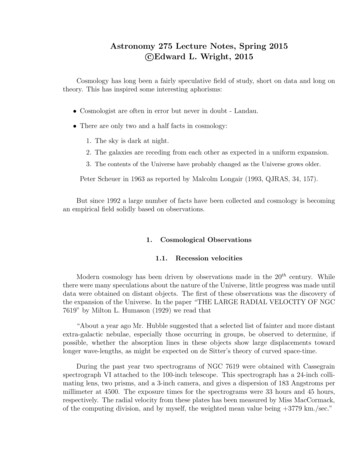
Transcription
Volume 7Issue 1The Interactive Astronomy Textbookby Christopher J. FlukeSwinburne University of TechnologyDavid G. BarnesSwinburne University of TechnologyThe Astronomy Education Review, Issue 1, Volume 7, 2008 2008, Christopher Fluke. Copyright assigned to the Association of Universities for Research inAstronomy, Inc.AbstractWe introduce the use of in situ interactive three-dimensional (3-d) figures in digital astronomy textbooksas a means of enhancing student learning. The recent 3-d extensions to the Adobe Portable DocumentFormat (PDF), combined with simple JavaScript, provide new ways to present intrinsically 3-d models,data sets, and instructional diagrams in digital publications. This is an enhancement to the usual methodof presenting static, two-dimensional views, or "comic strip" sequences, to indicate changes in viewpoint.Interactive figures provide opportunities for students to undertake active learning while reading atextbook: they are able to explore and uncover the connections between viewpoint, orientation, and the 3d nature of models and data sets for themselves.This version of the article, created to accompany the standard AER versions, contains threedimensional figures integrated into the document. Adobe Acrobat Reader 8 is required to use the 3d functionality. The standard AER versions may be accessed athttp://aer.noao.edu/cgi-bin/article.pl?id 264 (HTML) pdf (PDF with static figures).1. INTRODUCTION"His pattern indicates two-dimensional thinking." Spock (Star Trek II: The Wrath of Khan)There is a long tradition of using textbooks to teach astronomy as alternatives to original scientific works,journal articles, and other academic publications. Gingerich (1990) summarizes a number of the mostinfluential texts of the last 800 years, starting with Sacrobosco’s Sphere (c. 1220), which appeared innumerous editions over the following centuries. A key component of the majority of these earlyastronomy texts, particularly those aimed at an introductory or nonscientific audience, was the use ofimages. In fact, one of the earliest extant scientific graphs is in the appendix of an astronomy text,
Macrobius’s commentary on Cicero’s In Somnium Sciponis (Macrobius Boetius in Isagog. Saec. X),which was transcribed by an unknown monk in the 10th or 11th century CE (Funkhouser 1936 andfigures therein). The graph is a diagrammatic representation of the motion of the planets relative to theecliptic versus time.While the astronomy content may have changed over time, the reliance on figures to support the text hasnot; open any modern astronomy textbook, and it is full of photographs, visualizations, and instructionaldiagrams. Bruning (2007b, see Table 4) provides counts of the number of figures present in a survey of21 recently published astrophysics textbooks for astronomy majors, showing that figures contributedbetween 5% and 39% of the total page layout, with an average contribution of 25%.Prior to the computer-enabled multimedia revolution (especially the development of CD-ROM and, morerecently, DVD technologies) and the introduction of the World Wide Web (WWW) (Berners-Lee et al.1994), astronomy texts were almost exclusively static and two-dimensional (2-d). The main exceptions tothis were the elaborate volvelles or rotula that were introduced in the 13th century by English historianMatthew Paris. A volvelle uses a combination of rotatable paper disks and string markers, which werebound into astronomy texts as early interactive displays. Now mainly a historical curiosity, volvelles haveevolved into the modern cardboard or plastic planispheres. For discussions of the use of volvelles inastronomy, ranging from textbooks to medical diagnosis via astrology, see Stebbins (1959), Robbins(1970), Gingerich (1990), and Brück & Conway-Pikorski (1998).In the multimedia/WWW era, there has been a revolution in publication. This has occurred in both theacademic world, where digital publication of research journal papers has become standard (the presentjournal being an exemplar of this), and in education. Rich content, such as animations, movies, andinteractive demonstrations, are provided to students on CD-ROMs or as URL links as part of astronomytextbook packages. Of the 23 introductory astronomy textbooks examined by Bruning (2007a), 18 had anancillary CD-ROM with images and animations, 4 had a supporting Web site, and 3 texts were identifiedas "e-Books."To date, these enhanced media have not been fully integrated into a stand-alone textbook format (but seeour discussion of Web page presentations in the next section). Instead, the student is required to leave thetext that he or she is reading (either paper based or electronic) to insert a CD-ROM, download a movie, oropen a Web link. This can generate additional problems, such as compatibility issues between conflictingoperating systems and computing platforms (Mac OS X vs. Windows vs. Linux), difficulties in installingspecific software, and so on. These activities would all seem to distract from the continuity of an "all-inone" educational experience—an actual enhanced, interactive textbook. But does such a product exist?2. INTERACTIVE DIGITAL PUBLICATIONS AND 3-d PDFThe Portable Document Format (PDF), developed by Adobe Systems Incorporated as an open documentstandard, was released in the early 1990s. It has rapidly become the de facto standard for digitalpublication, replacing Adobe’s PostScript. One of the main advantages of PDF is that the resultingdocuments are platform independent, so documents are easily transferable between different operatingsystems, and there is some certainty that all readers will see the same content in the same way. PDF filesmay be produced from a range of commercial desktop publishing packages, along with free applicationslike LaTeX.An exciting addition to the PDF standard was announced by Adobe in May 2007: Adobe Acrobat 3DVersion 8. This update enables the inclusion of interactive figures within PDF documents, which can beviewed and modified using the freely downloadable Acrobat Reader Version 8. Aimed initially at the
engineering market, in which computer-aided design/computer-aided modelling (CAD/CAM)applications produce 3-d models, 3-d PDF can be used for a range of other purposes. This includes thepresentation of scientific data (Barnes & Fluke 2008 [hereafter BF]; Goodman et al. 2008), and, as wewill describe here, a step toward a self-contained, interactive digital textbook.In BF, we demonstrate how a variety of scientific data sets may be presented in an interactive form,including point data, iso-density surfaces, and volume rendering. Two of these demonstrations areenhanced through the use of JavaScript, which allows custom controls such as buttons and menu items tobe added to the file and linked to the 3-d figures. The interactive presentation of 3-d data sets providesnew opportunities for knowledge discovery: published figures are subjected to a higher degree of peerscrutiny, and every reader can have a unique experience by controlling the way data are viewed.The majority of the examples in BF and in the present article were produced using the S2PLOTprogramming library (Barnes et al. 2006), which provides a straightforward pathway for creating aninteractive model via output in an intermediate data format (VRML). The VRML model is suitable fordirect inclusion in PDF using Adobe Acrobat 3D Version 8.0, currently only available for Windows. Arange of CAD/CAM and graphics formats produced from standard 3-d modelling packages, includingAutodesk’s 3ds Max and NewTek’s Lightwave 3D, can also be imported.The general process for including scientific data sets (such as demonstrated in the figures below) is asfollows:1. Prepare a representation of the data in 3-d space. This may require an appropriate conversion fromspherical (e.g., right ascension, declination, distance) to Cartesian coordinates, and the creation of textlabels and other annotations2. Describe this data representation in a 3-d format that Adobe Acrobat 3D can import, such as VRML,Universal 3D (U3D), or Adobe’s PRC format3. Save/export the digital text file in PDF with appropriate spaces left for the 3-d figures4. Open the PDF file in Adobe Acrobat 3D and add the data file as a 3-d annotation5. Optionally, add JavaScript code to the 3-d figure and form elements in the PDF document to providemodel-specific interactive featuresWe note that alternative pathways exist that do not require the author to use Adobe Acrobat 3D, such ascreating U3D format figures that may be imported directly via the LaTeX documentation preparationsystem. Stand-alone viewers are available for 3-d formats such as VRML, so that the data models can beused within other contexts (including presentation on Web pages), and 3-d figures may be extracted fromthe PDF file if the end user has access to Adobe Acrobat 3D. There may be advantages in a usercommunity sharing resources for the creation of standard figure components; we envisage makingS2PLOT samples available as they are developed.While elements of the desired integrated interactivity might seem to be available solely through Web pagedelivery, this approach has a few limitations: Cross-platform and cross-browser issues abound: what works with Explorer on Windowsmachines may not work with Safari on a Mac.Formatting and layouts are not strictly adhered to because the user may not have particular fontsinstalled or may choose to change default font size, etc.Web pages are ephemeral: teachers and students who have found a good online astronomy text orfigure may not be able to return to it in the future.Most important, unless the user downloads the entire Web site in advance, there is a need for theuser to be online—a situation that might not be practical for all students.
This last limitation can be reduced somewhat if the Web content is reproduced on a CD-ROMaccompanying a textbook, but this requires the added overheads of authoring, burning, and distribution.As a fully self-contained interactive text, a PDF document works across all the main platforms (Windows,Mac, Linux), formatting is preserved, and the PDF file can be downloaded once and read offline.3. INTERACTIVE EXAMPLES FROM ASTRONOMYThere is a clear application for 3-d PDF in teaching a range of scientific and mathematical disciplines(e.g., presenting the 3-d chemical structures of DNA and other biological molecules, investigating thetracks of particles produced in a high-energy physics experiment, or plotting strange attractors and othercomplex 3-d mathematical entities). In this article, we focus our attention on astronomy.We believe that there are pedagogical advantages when students are able to interact with 3-d figuresdirectly connected with the accompanying text. In BF, we presented an instructional diagram of theunified active galactic nuclei (AGN) model. Because the AGN model is interactively rotated, the visibilityof the jet, dusty torus, and broad and narrow line regions changes, revealing the link between AGNclassification and orientation. Building on this idea, the examples that follow demonstrate severalstandard 3-d problems that an introductory astronomy textbook is likely to cover. Usually, these arepresented as 2-d static figures, relying on the choice of viewpoint or using a comic strip sequence offrames to show time dependence or changes in orientation. The relationship between these viewpointsmay not be intuitive to students, particularly when they are presented before the student has developed aninternal (cognitive) model of the 3-d configurations.We contend that interactive figures enable the student to discover the connections between orientationsand, we hope, improve their conceptual understanding of the 3-d nature of astronomical objects,compared with using static 2-d figures or even prerendered animation sequences (in which the student isagain only presented with one viewpoint and cannot interact with the model except by starting andstopping the animation). This interactive approach promotes an active learning experience.We note that the figures are only interactive in the PDF version of this article, and require Acrobat ReaderVersion 8.0 or later.
3.1 Solar System Orbits: The Inclination of PlutoIf a single example from astronomy is sufficient to justify the use of interactive and 3-d figures, it is thedemonstration of the inclination of Pluto’s orbit (17.16 ). In Figure 1, we show the orbits of the eightplanets (blue lines; Earth orbit is cyan line) and Pluto (red line). By clicking on the diagram and theninteractively altering the viewing position and direction, the reader can compare the orbits of the majorSolar System bodies in their own time and following their own "learning path." They can inspect theorbits from directly above the plane of the Solar System, from edge-on, and from oblique angles. Withappropriate context and prompting in the text preceding the figure, most students will easily deduce thatPluto is the odd one out in terms of its orbit. Furthermore, the 3-d presentation of the orbits allows thereader to make the important discovery that the orbits of Pluto and Neptune do not intersect even thoughPluto is at times nearer to the Sun than the eighth planet.Figure 1. The inclination of Pluto’s orbit (red) with respect to the plane of the Solar System is clearlyapparent. The cyan line indicates Earth’s orbit.3.2 The Cause of the SeasonsAt an introductory level, one of the most widely held astronomy misconceptions relates to the cause of theEarth’s seasons. Although the Earth’s elliptical orbit does bring it marginally closer to the Sun in
December than in June, it is the axial tilt that has the dominant effect of producing opposite pairs ofseasons between the northern and southern hemispheres. A figure representing this relationship needs toshow the Earth’s orbit around the Sun and its axial tilt, while maintaining the correct spatial relationshipsbetween the two. A view from above the plane of the Earth’s orbit is insufficient because the tilt of theEarth is not easily discernible. An oblique view is unsatisfactory because it distorts the Earth’s (nearly)circular orbit shape in projection, which might be confused with the orbit’s ellipticity. An interactive 3-drepresentation allows the reader to choose his or her preferred viewpoint so that the fixed direction of theEarth’s axis and the (nearly) circular orbit shape are both apparent. The interactive 3-d figure suppressesthe (incorrect) perception that the orbit is noncircular because (1) the reader can rotate the viewpoint to aposition where the orbit is circular, and (2) the more natural perspective projection is used rather than theorthographic projection typical of 2-d figures. This is demonstrated in Figure 2.Figure 2. The cause of the Earth’s seasons is the fixed direction of the axial tilt (red line) as the Earth(blue sphere) orbits the Sun (yellow sphere) in a nearly circular orbit. The cyan line indicates the Earth’sequator. The Earth, the Sun, and the Earth’s orbit are not drawn to scale.3.3 Radar Mapping of Solar System BodiesA growing number of Solar System bodies have now been mapped in 3-d. Whereas the Sun and planetsare relatively smooth, oblate spheroids, the multitude of asteroids, satellites, and other small Solar Systembodies have much more interesting nonspherical shapes. One of the most startling is the dumbbell (or dog
bone!) geometry of the M-class asteroid 216 Kleopatra (Ostro et al. 2000), as shown in Figure 3. Threedimensional interactive figures of unusual shapes and structures are far more instructive—at leastqualitatively—than any collection of static 2-d projections. We contend that a figure such as this oneenables the reader to construct a more accurate cognitive model of the asteroid’s true shape than he or shewould from 2-d figures, and in less time.Figure 3. Asteroid 216 Kleopatra. The shape of this asteroid was determined using the S-band radarsystem of the Arecibo Observatory to create a series of delay Doppler images that are combined todetermine the 3-d shape. See Ostro et al. (2000) for details.3.4 The 3-d Distribution of Nearby StarsOur next example takes us out of the Solar System and into the Milky Way. Using data from theHIPPARCOS catalogue (Perryman et al. 1997), the 3-d distribution of stars with measured parallaxeswithin 100 light years is shown in Figure 4. For a star with HIPPARCOS parallax p (milliarcseconds), thedistance is d 3260/p light years. Stars are colored according to spectral type, and coordinate lines aredrawn at 25, 50, 75, and 100 light years. This figure introduces reader control of diagram content.Clicking a button selects which stars are shown, based on their distance to the Sun. A separate buttoncontrols the visibility of the coordinate lines. With the Sun at the center, the stellar distribution is fairlyuniform out to 100 light years because this is well below the thickness of the galactic disk.
255075100 ly GRIDFigure 4. The 3-d location of stars within 100 light years of the Sun. Stellar distances are calculated usingparallax data from the HIPPARCOS catalogue. Stars are colored according to spectral type. By clickingon one of the four buttons, stars within the indicated radius are displayed. The GRID button controls thevisibility of the coordinate grid.3.5 PulsarsPulsars represent an end point of stellar evolution for massive ( 6–10 solar masses) stars. They areextremely compact (radius 10 km) and rapidly rotating (spin rates from 1ms to 10s), with characteristicmasses of about 1.4 solar masses and magnetic field strengths above 10 9 Gauss. Because their formationis quite violent, the pulsar spin axis and the magnetic field are usually not aligned. Although there arecurrently 1,600 known pulsars, this probably represents less than 5% of the pulsar population in theMilky Way. Pulsars are only seen if the "lighthouse" beam of their emission intersects the Earth. Thiseffect is demonstrated in Figure 5, where we present a conceptual model of a pulsar. The reader can movethe camera position and angle of view to discover that the beamed pulsar radiation is only visible fromspecial locations in space.
Figure 5. The "lighthouse" beams of emission (blue cones) from a pulsar (yellow sphere). The magneticaxis (blue line) is not aligned with the rotation axis (red line). The pulsar can only be detected with a radiotelescope if the emission cone sweeps across the Earth. The JavaScript-enabled animation in this figuremay be controlled using the Pause/Play button on the Adobe Reader 3-d toolbar.3.6 The Filamentary Large-Scale Structure of the UniverseGalaxy redshift surveys mapping the 3-d distribution of galaxies have been growing in complexity sincethe Centre for Astrophysics (CfA) surveys of the 1980s (Davis et al. 1982; De Lapparent, Geller, &Huchra 1986; Geller & Huchra 1989). The 2dF Galaxy Redshift Survey (Colless et al. 2001), the SloanDigital Sky Survey (Stoughton et al. 2002), and the 6dF Galaxy Survey (Jones et al. 2004) have nowmapped 106 galaxies, confirming the discoveries of the original CfA survey: that the large-scalestructure of the Universe comprises a complex array of filaments, walls, sheets, and voids. The customaryway to plot galaxy surveys is to use a cone or wedge diagram of right ascension, declination, and redshift(RA, Dec, z) triples. Figure 6 shows data from the CfA2 survey, selecting galaxies between declination 0and 15 degrees, and velocities below 10,000 km/s. When displayed in 2-d, it is much harder to identifyspecific structures because of projection effects. Interactive exploration of a 3-d galaxy map is much moreinstructive because changes in orientation allow features like the Great Wall of galaxies (the extended,overdense region between 9h and 15h RA) to be easily discovered. It is important to remember thatredshift maps are not spatial maps; they use redshift as a proxy for distance via the Hubble law. Propermotions of galaxies within clusters are superimposed on the Hubble flow, leading to the "fingers of God"artifacts pointing toward the origin.
GRIDFigure 6. The large-scale structure of the Universe from the CfA2 galaxy survey. Plotted on this 3-dwedge diagram are galaxies between declination 0 and 15 degrees, and velocities below 10,000 km/s.There are gaps in the right ascension coverage between RA 5h30m to 6h30m, and 18h to 20h. The twosets of red declination rings indicate velocities 5,000 km/s and 10,000 km/s. Clicking the GRID buttontoggles the visibility of the coordinate lines.4. CONCLUSIONSIn this article, we have demonstrated how 3-d PDF can be used to provide an active learning experiencefor students by embedding interactive models within a digital document. We have included examplesranging from conceptual models (Pluto’s orbital inclination, the cause of the seasons, the rotation of apulsar) to 3-d geometry (the shape of Kleopatra) and astronomical data sets (HIPPARCOS star catalogueand CfA2 galaxy redshift survey). It is easy to envisage numerous other cases in astronomy teaching inwhich an interactive presentation, combined with features such as animation and selection, can enhancethe student learning experience.
Consider a traditional PDF file containing narrative text and vector or bitmap graphics. Add one or moreembedded 3-d models, a few GUI elements (buttons, checkboxes, and so on), and some relatively simpleJavaScript code. The result is a self-contained document that, when viewed with the Adobe Reader,constitutes an application of sorts. The reader has access to all the customary content of a text article, plusin situ interactive visualizations of 3-d objects. This is the interactive textbook.AcknowledgmentsWe are grateful to the referee, Chris Impey, for his encouraging and insightful comments on this work.Web LinksAdobe Systems Inc.: http://www.adobe.comAutodesk: http://www.autodesk.comNewTek: http://www.newtek.comReferencesBarnes, D. G., & Fluke, C. J. 2008/in press, "Incorporating Interactive 3-Dimensional Graphics inAstronomy Research Papers," New Astronomy, DOI: 10.1016/j.newast.2008.03.008.Barnes, D. G., Fluke, C. J., Bourke, P. D., & Parry, O. T. 2006, "An Advanced, Three-DimensionalPlotting Library for Astronomy," Publications of the Astronomical Society of Australia, 23, 82.Berners-Lee, T., Cailliau, R., Luotonen, A., Neilson, H. F., & Secret, A. 1994, "The World Wide Web,"Communications of the ACM, 37, 76.Bruning, D. 2007a, "Survey of Introductory Astronomy Textbooks: An Update," Astronomy EducationReview, 5(2), 182. http://aer.noao.edu/cgi-bin/article.pl?id 218.Bruning, D. 2007b, "Survey of Introductory Astrophysics Textbooks," Astronomy Education Review,6(1), 80. http://aer.noao.edu/cgi-bin/article.pl?id 236.Brück, M. T., & Conway-Pikorski, M. 1998, "A Medieval Irish Treatise on Astronomy Recalled, with aMemoir of its Translator and Editor, Maura Power (1887-1916)," Irish Astronomical Journal, 25(1), 49.Colless, M., et al. 2001, "The 2dF Galaxy Redshift Survey: Spectra and Redshifts," Monthly Notices ofthe Royal Astronomical Society, 328, 1039.Davis, M., Huchra, J., Latham, D. W., & Tonry, J. 1982, "A Survey of Galaxy Redshifts. II-The LargeScale Space Distribution," Astrophysical Journal, 253, 423.De Lapparent, V., Geller, M. J., & Huchra, J. P. 1986, "A Slice of the Universe," Astrophysical Journal,302, L1.Funkhouser, H. G. 1936, "A Note on a Tenth Century Graph," Osiris, 1, 260.Geller, M. J., & Huchra, J. P. 1989, "Mapping the Universe," Science, 246, 897.
Gingerich, O. 1990, "Five Centuries of Astronomical Textbooks and Their Role in Teaching," in TheTeaching of Astronomy, Proceedings of IAU Colloq. 105, J. M. Pasachoff & J. R. Percy (Editors),Cambridge: Cambridge University Press, 189.Goodman, A. A., Rosolowsky, E. W., Borkin, M. A., Foster, J. B., Halle, M., Kauffmann, J., & Pineda, J.E. 2008, "The Seeking and Finding the ’True’ Mass Distribution in Star-Forming Molecular Clouds,"manuscript submitted for publication, 2007.Jones, D. H., et al. 2004, "The 6dF Galaxy Survey: Samples, Observational Techniques and the First DataRelease," Monthly Notices of the Royal Astronomical Society, 355, 747.Ostro, S. J., et al. 2000, "Radar Observations of Asteroid 216 Kleopatra," Science, 288, 836.Perryman, M. A., et al. 1997, "The HIPPARCOS Catalogue," Astronomy & Astrophysics, 323, L49.Robbins, R. H. 1970, "Medical Manuscripts in Middle English," Speculum, 45(3), 393.Stebbins, F. A. 1959, "A Sixteenth Century Planetarium," Journal of the Royal Astronomical Society ofCanada, 53, 197.Stoughton, C., et al. 2002, "Sloan Digital Sky Survey: Early Data Release," Astronomical Journal, 123,485.ÆRResources
As a fully self-contained interactive text, a PDF document works across all the main platforms (Windows, Mac, Linux), formatting is preserved, and the PDF file can be downloaded once and read offline. 3. INTERACTIVE EXAMPLES FROM ASTRONOMY There is a clear application for 3-d PDF in te

